Abstract
Cucumber (Cucumis sativus L., cv Poinsette) plants were sprayed with 20 millimolar 5-aminolevulinic acid and then incubated in the dark for 14 hours. The intact chloroplasts were isolated from the above plants in the dark and were exposed to weak light (250 micromoles per square meter per second). Within 30 minutes, photosystem II activity was reduced by 50%. The singlet oxygen (1O2) scavengers, histidine and sodium azide (NaN3) significantly protected against the damage caused to photosystem II. The hydroxyl radical scavenger formate failed to protect the thylakoid membranes. The production of 1O2 monitored as N,N-dimethyl p-nitrosoaniline bleaching increased as a function of light exposure time of treated chloroplasts and was abolished by the 1O2 quencher, NaN3. Membrane lipid peroxidation monitored as malondialdehyde production was also significantly reduced when chloroplasts were illuminated in the presence of NaN3 and histidine. Protochlorophyllide was the most abundant pigment accumulated in intact chloroplasts isolated from 5-aminolevulinic acid-treated plants and was probably acting as type II photosensitizer.
Full text
PDF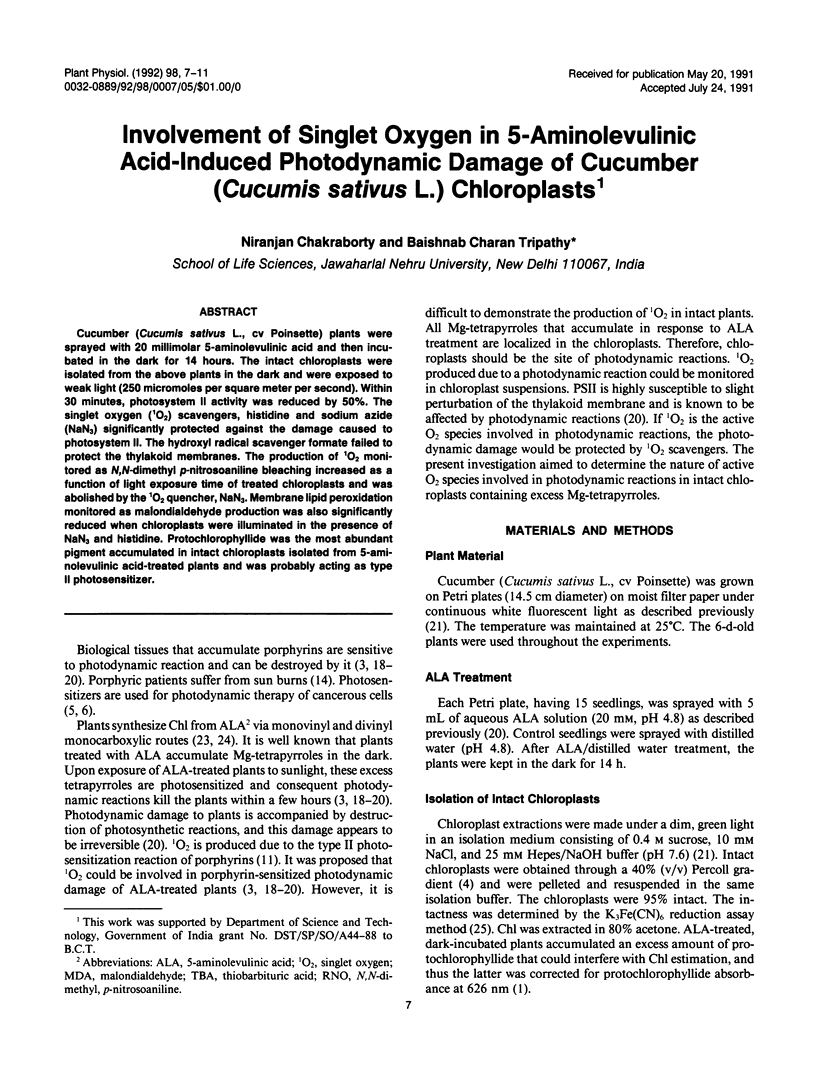
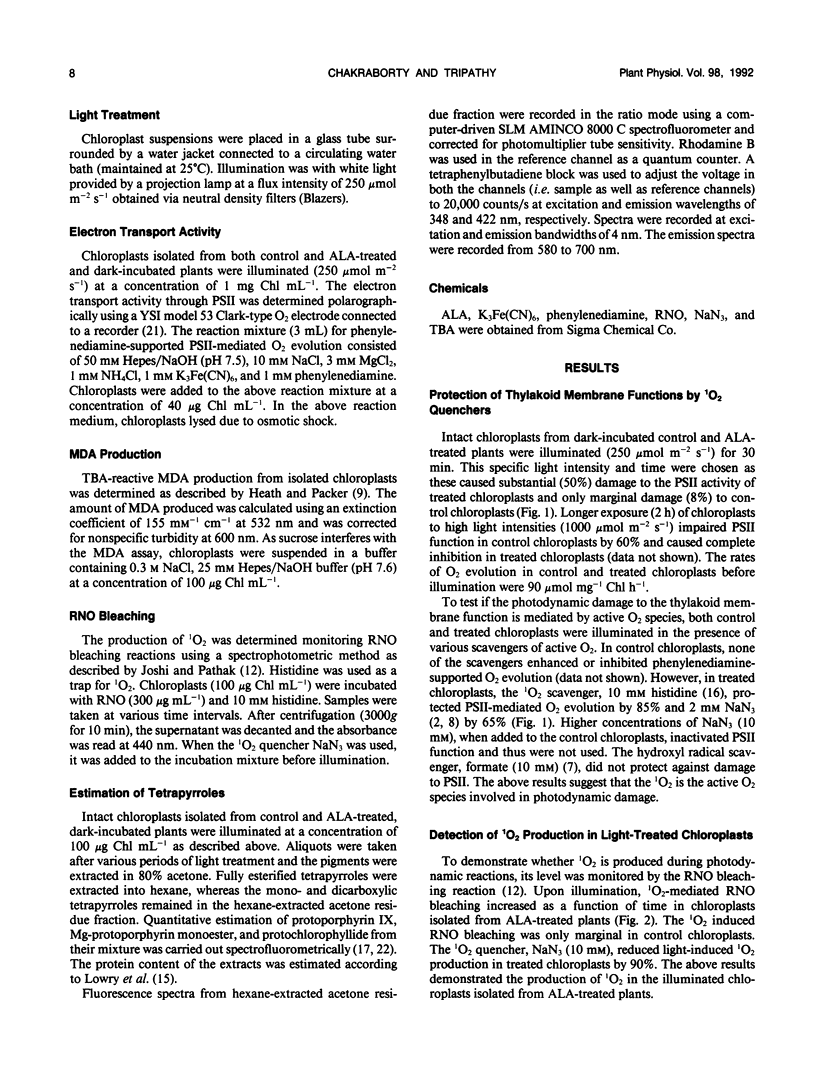
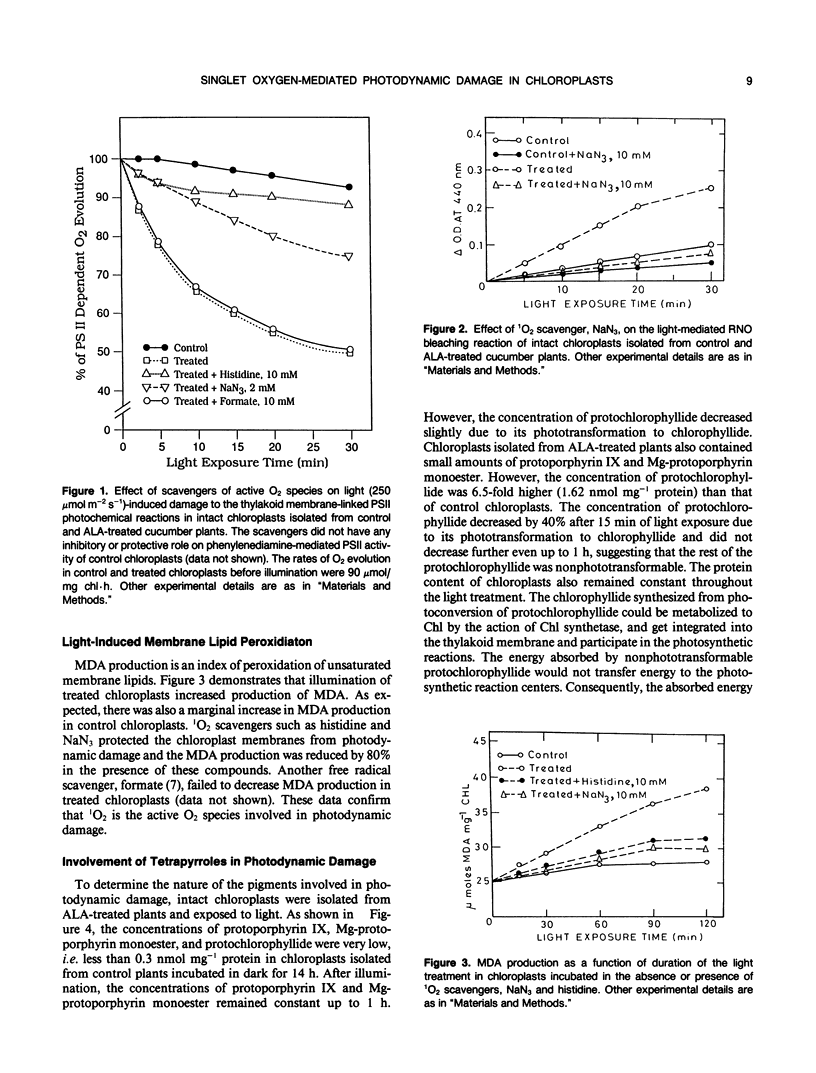
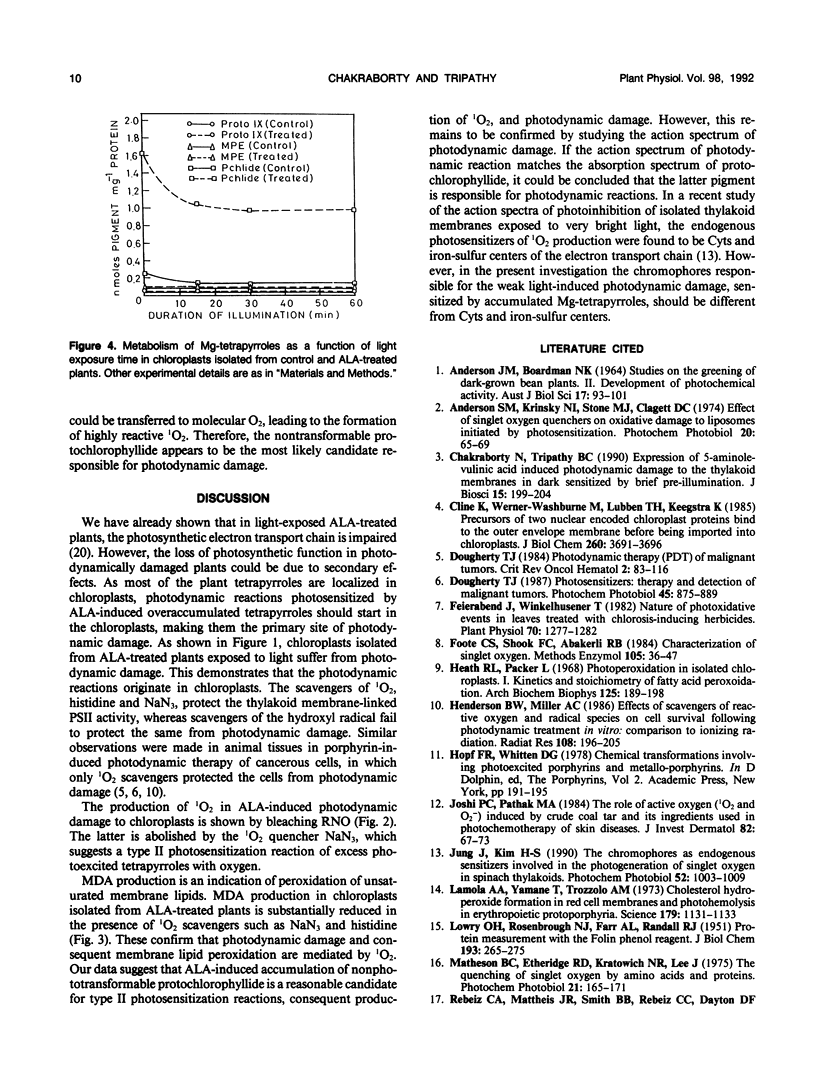
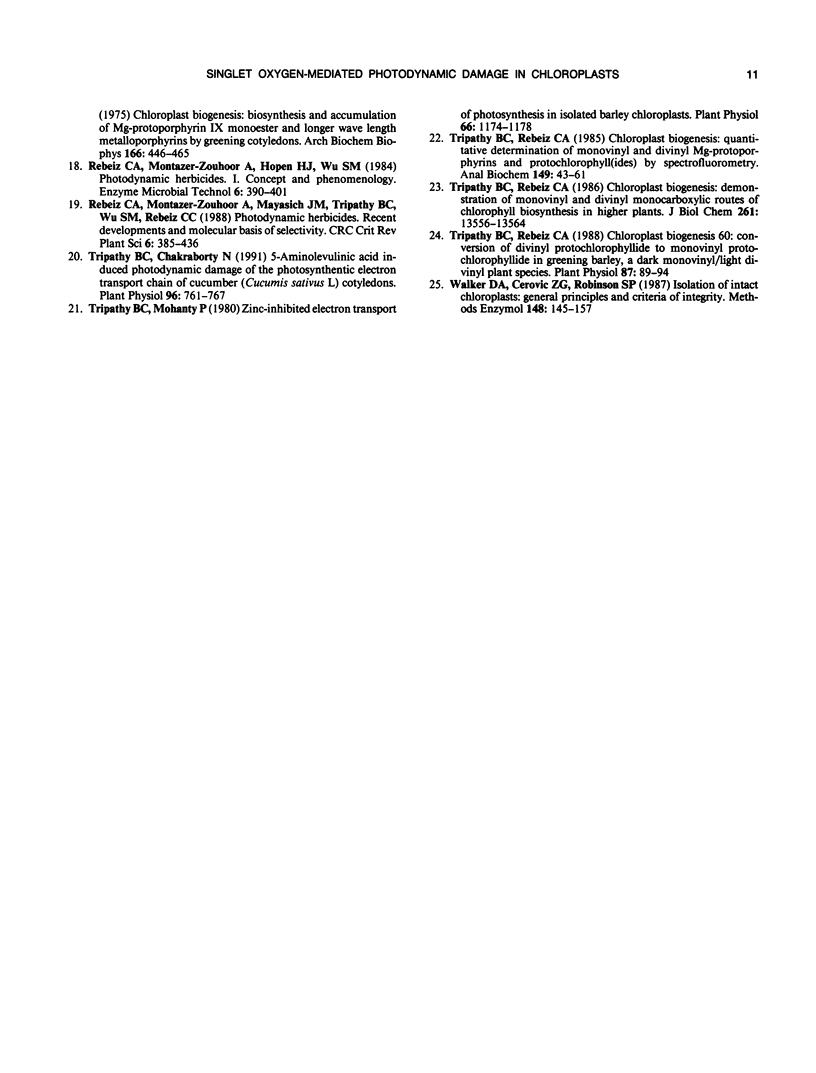
Selected References
These references are in PubMed. This may not be the complete list of references from this article.
- Anderson S. M., Krinsky N. I., Stone M. J., Clagett D. C. Effect of singlet oxygen quenchers on oxidative damage to liposomes initiated by photosensitization or by radiofrequency discharge. Photochem Photobiol. 1974 Jul;20(1):65–69. doi: 10.1111/j.1751-1097.1974.tb06549.x. [DOI] [PubMed] [Google Scholar]
- Cline K., Werner-Washburne M., Lubben T. H., Keegstra K. Precursors to two nuclear-encoded chloroplast proteins bind to the outer envelope membrane before being imported into chloroplasts. J Biol Chem. 1985 Mar 25;260(6):3691–3696. [PubMed] [Google Scholar]
- Dougherty T. J. Photodynamic therapy (PDT) of malignant tumors. Crit Rev Oncol Hematol. 1984;2(2):83–116. doi: 10.1016/s1040-8428(84)80016-5. [DOI] [PubMed] [Google Scholar]
- Dougherty T. J. Photosensitizers: therapy and detection of malignant tumors. Photochem Photobiol. 1987 Jun;45(6):879–889. doi: 10.1111/j.1751-1097.1987.tb07898.x. [DOI] [PubMed] [Google Scholar]
- Feierabend J., Winkelhüsener T. Nature of photooxidative events in leaves treated with chlorosis-inducing herbicides. Plant Physiol. 1982 Nov;70(5):1277–1282. doi: 10.1104/pp.70.5.1277. [DOI] [PMC free article] [PubMed] [Google Scholar]
- Foote C. S., Shook F. C., Abakerli R. B. Characterization of singlet oxygen. Methods Enzymol. 1984;105:36–47. doi: 10.1016/s0076-6879(84)05006-0. [DOI] [PubMed] [Google Scholar]
- Heath R. L., Packer L. Photoperoxidation in isolated chloroplasts. I. Kinetics and stoichiometry of fatty acid peroxidation. Arch Biochem Biophys. 1968 Apr;125(1):189–198. doi: 10.1016/0003-9861(68)90654-1. [DOI] [PubMed] [Google Scholar]
- Henderson B. W., Miller A. C. Effects of scavengers of reactive oxygen and radical species on cell survival following photodynamic treatment in vitro: comparison to ionizing radiation. Radiat Res. 1986 Nov;108(2):196–205. [PubMed] [Google Scholar]
- Joshi P. C., Pathak M. A. The role of active oxygen (1O2 and O(2)) induced by crude coal tar and its ingredients used in photochemotherapy of skin diseases. J Invest Dermatol. 1984 Jan;82(1):67–73. doi: 10.1111/1523-1747.ep12259146. [DOI] [PubMed] [Google Scholar]
- LOWRY O. H., ROSEBROUGH N. J., FARR A. L., RANDALL R. J. Protein measurement with the Folin phenol reagent. J Biol Chem. 1951 Nov;193(1):265–275. [PubMed] [Google Scholar]
- Lamola A. A., Yamane T., Trozzolo A. M. Cholesterol hydroperoxide formation in red cell membranes and photohemolysis in erythropoietic protoporphyria. Science. 1973 Mar 16;179(4078):1131–1133. doi: 10.1126/science.179.4078.1131. [DOI] [PubMed] [Google Scholar]
- Matheson I. B., Etheridge R. D., Kratowich N. R., Lee J. The quenching of singlet oxygen by amino acids and proteins. Photochem Photobiol. 1975 Mar;21(3):165–171. doi: 10.1111/j.1751-1097.1975.tb06647.x. [DOI] [PubMed] [Google Scholar]
- Tripathy B. C., Chakraborty N. 5-Aminolevulinic Acid Induced Photodynamic Damage of the Photosynthetic Electron Transport Chain of Cucumber (Cucumis sativus L.) Cotyledons. Plant Physiol. 1991 Jul;96(3):761–767. doi: 10.1104/pp.96.3.761. [DOI] [PMC free article] [PubMed] [Google Scholar]
- Tripathy B. C., Mohanty P. Zinc-inhibited Electron Transport of Photosynthesis in Isolated Barley Chloroplasts. Plant Physiol. 1980 Dec;66(6):1174–1178. doi: 10.1104/pp.66.6.1174. [DOI] [PMC free article] [PubMed] [Google Scholar]
- Tripathy B. C., Rebeiz C. A. Chloroplast Biogenesis 60 : Conversion of Divinyl Protochlorophyllide to Monovinyl Protochlorophyllide in Green(ing) Barley, a Dark Monovinyl/Light Divinyl Plant Species. Plant Physiol. 1988 May;87(1):89–94. doi: 10.1104/pp.87.1.89. [DOI] [PMC free article] [PubMed] [Google Scholar]
- Tripathy B. C., Rebeiz C. A. Chloroplast biogenesis. Demonstration of the monovinyl and divinyl monocarboxylic routes of chlorophyll biosynthesis in higher plants. J Biol Chem. 1986 Oct 15;261(29):13556–13564. [PubMed] [Google Scholar]
- Tripathy B. C., Rebeiz C. A. Chloroplast biogenesis: quantitative determination of monovinyl and divinyl Mg-protoporphyrins and protochlorophyll(ides) by spectrofluorometry. Anal Biochem. 1985 Aug 15;149(1):43–61. doi: 10.1016/0003-2697(85)90475-0. [DOI] [PubMed] [Google Scholar]


